Learning Objectives
After this course, participants will be able to:
- Identify candidates for the technologies described using the appropriate FDA indications.
- Explain how to counsel recipients on key features and benefits of the technologies described in the presentation.
- Outline how to implement best practices in bone conduction fitting with diverse patient populations.
Introduction
For today’s presentation, we'll start with an overview of the Cochlear Baha 5 System. For us, it is important that all candidates for and recipients of a bone conduction solution are able to find the solution that works best with their individual lifestyle. This is why the Baha 5 System is the most complete portfolio in bone conduction. Figure 1 is an overview of the Baha 5 Systems portfolio.
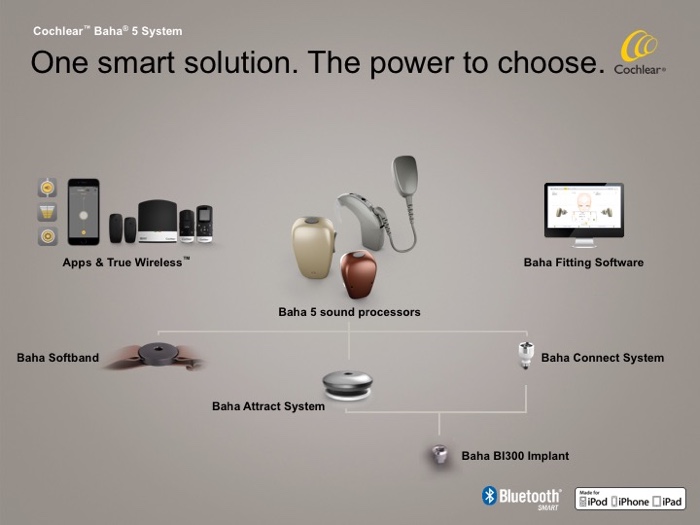
Figure 1. Baha 5 Systems approach.
The BI300 implant is the foundation of the portfolio. This implant has evolved and has been highly successful over a 30+ year history. The Cochlear approach to bone anchored solutions includes two attachment points. One is the Baha Attract System, which is a magnetic system that allows no skin penetration; it is a through-the-skin transfer of vibrational energy. We also have the Baha Connect System that uses the abutment (a through-the-skin system that accesses direct bone conduction). Then, we have the Baha Softband application. The Baha Softband application is a non-surgical option that's typically offered to pediatric patients under the age of five years old. It is also a useful tool for demonstrating and evaluating patients who are considering Baha as a treatment option. Finally, in some adult cases where surgery is either contraindicated or not available to the patient, they can use this as their preferred wearing option.
There are three choices of sound processors in this portfolio - Baha 5, Baha 5 Power, and Baha 5 SuperPower, and I will review them in this course. For professionals, smart and intuitive fitting is possible through Baha Fitting Software with a host of fitting tools to best fit according to patient need. Finally, the True WirelessTM accessories and Baha Smart App are unique to bone conduction in terms of offering both Bluetooth connectivity and Made-for-iPhone connectivity.
Small and Smart
In 2015, we launched the Baha 5 Sound Processor. This design won a Red Dot Award in 2015. The BCDrive™ transducer is the heart of the bone conduction system; it is the engine that drives it. It allows for converting the amplified signal into vibrational energy, which is applied to the skull to access the bone conduction system. The BCDrive Transducer enabled a more efficient and more robust design, in a much smaller package. The Ardium™ Smart Platform is the chip set that enables features like scene analysis, SmartSound® iQ and also 2.4 GHz True Wireless.
More Power
Even as significant as the Baha 5 Sound Processor achievement was, there was still an unmet need to help patients with greater degrees of hearing loss. This population includes those with mixed hearing loss and also those with single sided deafness (SSD) who may have lost some hearing in the high frequencies after they were implanted. Also included are patients who have a large measured transcranial attenuation as the signal crosses the skull; they need the extra force output from a power device.
The new products I’ll cover today - the Baha 5 Power and the Baha 5 SuperPower - deliver more power. The Baha 5 technology is designed for both mixed and conductive losses and SSD. Higher power applications are appropriate for those patients with SSD who need extra levels of power to overcome transcranial attenuation. More power is also beneficial for patients who select the Baha Attract System as their preferred attachment point. With the Baha Attract System, tissue over the implant magnet can attenuate signal in the high frequencies, and these power options can help us to access more gain in the high frequencies.
Baha 5 System Portfolio of Products
As I mentioned, the Baha 5 was introduced in 2015 and we are pleased to now introduce the Baha 5 Power and the Baha 5 SuperPower.
Baha 5 Sound Processors
The Baha 5 sound processors share unique technologies and building blocks to deliver a smart and seamless hearing experience for all patients. We were the first to have the industry's smallest sound processor, and we have the only smart processors that allow direct-to-device wireless streaming and control through the Made for iPhone capability.
Let's talk about the fitting ranges and the bone conduction thresholds for each patient that we're going to treat. The Baha 5 device can accommodate up to a 45 dB sensorineural hearing level in the bone conduction thresholds, depicted in the yellow shaded zone on the audiogram in Figure 2.
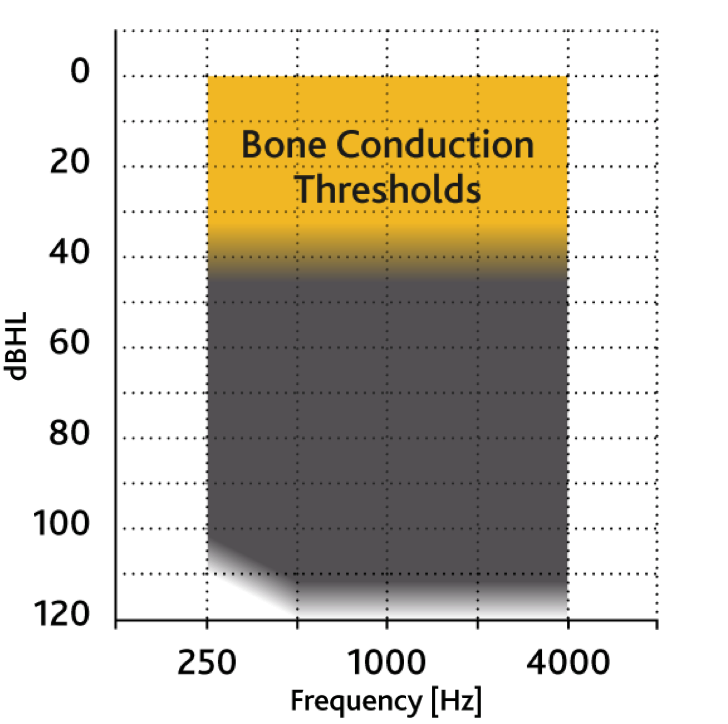
Figure 2. Baha 5 fitting range.
The Baha 5 Sound Processor is the industry's smallest processor, but it delivers the same power output as other devices with fitting ranges up to 45 dB SNHL. Because of its small footprint, this device requires a size 312 battery. The only onboard control option is the single program streaming button on the top. This allows patients to access different programs if they're added into the device, and to initiate and terminate streaming activity, if desired. We also offer SmartSound iQ and Cochlear's True Wireless technology through the Ardium chip set. This technology provides access to the Made for iPhone streaming capabilities, where no intermediate device is needed to make phone calls or stream media from your iPhone.
Identifying Candidates
Power users want the latest technology in a head-worn option. Both our Baha 5 Power and SuperPower devices give us those options in a nice package. For Baha Attract users, and candidates with mixed hearing loss or SSD who require extra power, these power options are exactly what they have been asking for. With the pediatric population where mixed hearing loss is present and we need features like warning lights and tamper-proof battery doors, the Baha 5 Power and SuperPower are available.
Baha 5 Power
The Baha 5 Power device will fit up to a 55 dB sensorineural hearing level, so it adds an additional 10 dB of range to the Baha 5 fitting range (Figure 3).
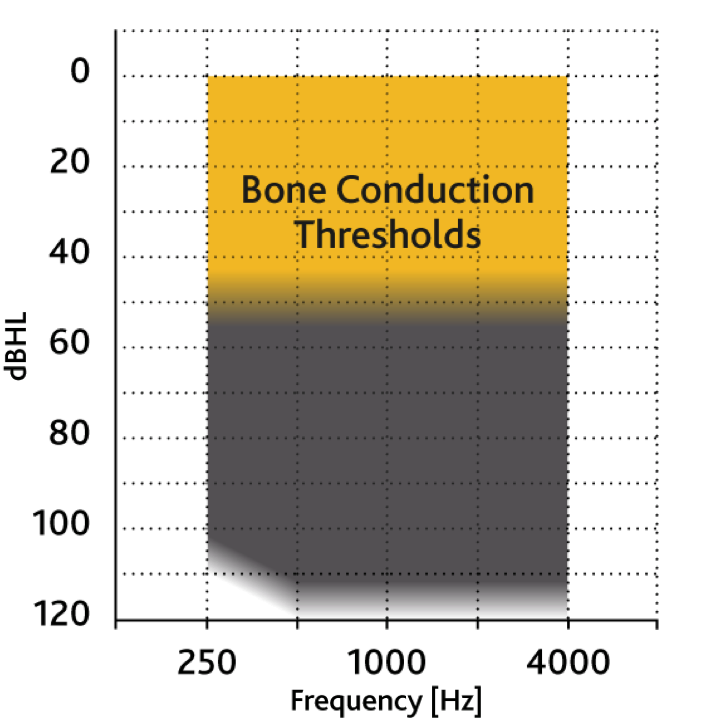
Figure 3. Baha 5 Power sound processor fitting range (yellow shaded area).
The Baha 5 Power Sound Processor is packed full of features and benefits that we introduced with the original Baha 5 (Figure 4). We still have the button at the top of the device that allows for onboard changing of the programs, and also initiation and termination of streaming through a push-button paradigm. On the right-hand side of the device, there is a rocker volume control, which is new to the Baha 5 Power and SuperPower devices. This allows the end user to control volume right from the device. There is also a visual indicator and LED that can either be turned on or off in software, depending on the needs of the clinician and the user. A 675 battery powers the device, and it has an in-built tamper-proof battery door. Again, with the Baha 5 Power, we offer access to SmartSound iQ (which is using our scene analysis and automatic function) along with the Cochlear True Wireless access, Bluetooth Smart, and Made for iPhone capabilities.
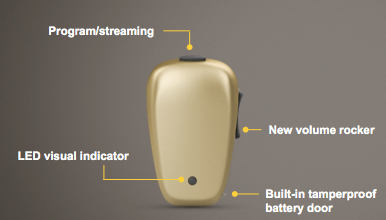
Figure 4. Baha 5 Power sound processor.
Ear Level Sound Processor: Baha 5 SuperPower Sound Processor
To round out the portfolio, we're introducing the Baha 5 SuperPower, which is an ear level sound processor that will fit up to a 65 dB sensorineural level. You can see from the form factor here that it looks similar to a sound processor from cochlear implant technology (Figure 5). We were able to use the best of our Nucleus cochlear implant technologies including rechargeable batteries and cabling to offer an ear level sound processor that fits up to a 65 dB sensorineural hearing level. The fitting range is also shown in Figure 5.
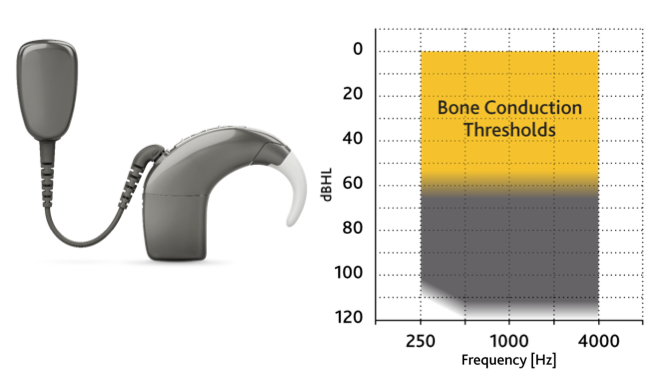
Figure 5. Baha 5 SuperPower Sound Processor and fitting range (yellow shaded area).
The Baha 5 SuperPower is revolutionary in that it utilizes Baha and Nucleus® technology to make it the only head-worn sound processor for up to 65 dB SNHL. It uses a rechargeable battery. In order to access the necessary power, it has a decoupled transducer arrangement where the transducer is separate rather than being in-built into the device. It also uses ear level microphones and the Baha technology on board, which enables access to SmartSound iQ, Cochlear True Wireless and the Made for iPhone technology. As we fit greater hearing loss levels, we do not have to sacrifice features and benefits; we offer parity across the board with the range of these devices.
EveryWear Fitting Options
With the Baha 5 SuperPower, we offer an EveryWear fitting feature, which includes three different options to help patients maximize every decibel of power from their device. We can offer fittings on the same ear, using either a behind-the-ear or an under-the-ear configuration. We can also use the opposite ear in certain situations, where we can place the sound processor behind the ear and use a longer cord that wraps around the back of the head to the transducer on the opposite side. Finally, in cases where we need the maximum flexibility, or for patients that need access from a dexterity standpoint, we can use a clip-on option. We use a longer cord, and the sound processor is clipped onto the shirt, which gives more of a body-worn configuration scenario. Any time you isolate the microphone from the transducer, that gives you the maximum amount of output. You can offer these three different fitting options to suit your patients’ unique needs.
On the left-hand side of Figure 6, is a patient with a BTE fitting. On the right-hand side, you can see the under-the-ear (UTE) fitting, which uses a special ear hook that allows for the sound processor to be fitted under the ear. Now, this can function in two very positive capacities. If a significant amount of power is being delivered to the implant embedded into the skull via osseointegration, at higher power levels, sometimes acoustic radiation or acoustic energy comes off the skull in a sounding board effect. The idea of placing the microphones at the bottom of the ear away from the skull gives us some isolation. This can also be deployed in previous patients that were using ear level or BTE devices that had their implant close to the pinnae, or in cases where patients need clearance for the wearing of hats or other kinds of options. This wearing option is a very useful feature to clinicians and end users.

Figure 6. BTE and UTE fitting with the Baha 5 SuperPower Sound Processor.
Baha Attract System
Figure 7 is a photograph of two people using the Baha Attract System (Figure 7). On the left is a man with a Baha 5 SuperPower device fitted with the Baha Attract Sound Processor Magnet. The young man on the right has the Baha 5 Power device behind the ear attached to the Sound Processor Magnet.

Figure 7. Baha 5 SuperPower and Baha 5 Power.
Figure 8 gives you a good idea of the differences between the various sound processors in this portfolio when used on a Baha Attract System. These are measured maximum force output curves that were generated on an artificial mastoid to simulate a through-the-skin conduction: the Baha 5 device is depicted in the grey lower curve; the Baha 5 Power is the green line; and, the Baha 5 SuperPower is the purple line.

Figure 8. Baha 5 sound processors on Baha Attract System.
Figure 9 shows a close-up look at the high frequency region between 2000 Hz and 6000 Hz. Our legacy power device, the BP110, is depicted by the red dotted line. The figure shows that In the higher frequency domain, the Baha 5 Power (green) gives additional gain or access to force output and gain. When we want to offer the maximum amount of gain available in the high frequency domain, the Baha 5 SuperPower (purple) affords us the opportunity to offer that -- up to 20 dB more.

Figure 9. Close-up of high frequency region: The Baha Attract System delivers more power in the high frequency range with Baha 5 Power (green curve) and Baha 5 SuperPower (purple curve) compared with the previous generation power device (red dotted curve).
Hearing Performance - Objective Testing. We performed in-house testing using the Baha Attract System with a group of five patients (Figure 10) and measured the results. The blue bar on the chart represents the unaided hearing score in a quiet environment using monosyllabic words. The grey bar is what we measured using a BP110 device, and the purple bar shows what we achieved with the Baha 5 SuperPower device with a 50 dB input. You can see a similar improvement across the board when we look at inputs to the device as high as 65 dB. We see an average of 28% improvement when in relation to a 50 dB input. That is important for patients, and the patients in the test series were elated with these outcomes.
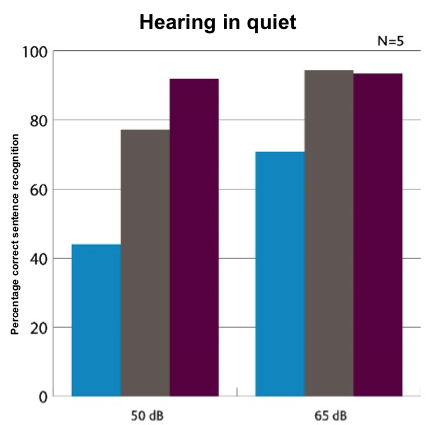
Figure 10. Hearing in quiet: unaided (blue), BP110 (grey), and Baha 5 SuperPower (purple).
Figure 11 demonstrates hearing in noise results using the HINT test. As you may be aware, the lower the number, the better the result. The blue bar demonstrates their actual hearing in noise performance on the HINT test with a 50% correct SRT. Notice that when we apply the BP110 Sound Processor (grey bar), there is improvement, but it still hovers around the 0 dB point. The purple area shows the improvement down to a -3 dB SNR with the Baha 5 SuperPower, which gives us a 3 dB improvement in hearing in noise over the legacy BP110 device. This is very beneficial for patients who need that power, such as these test subjects. They were able to realize significant improvement in hearing and noise with the Baha 5 SuperPower, and they were happy with the results that they achieved.

Figure 11. Hearing in noise: unaided (blue), BP110 (grey), and Baha 5 SuperPower (purple).
Baha Connect System
Figure 12 is a photograph of a man wearing the Baha 5 Power (left) and a woman wearing the Baha 5 SuperPower (right) – both using the Baha Connect System, which provides direct bone conduction via an abutment through the skin. For patients who are in need of maximum power through direct bone conduction, the Baha Connect system is the only direct bone conduction system with the capability of addressing hearing needs up to 65 dB SNHL.

Figure 12. Baha Connect System.
Figure 13 demonstrates the relative output force curves measured on a skull simulator (TU 1000) with a Connect system across the Baha 5 (grey), the Baha 5 Power (green) and the Baha 5 SuperPower (purple). You can see the relative amounts of gain for each sound processor across the frequency range.

Figure 13. Baha 5 sound processors on Baha Connect System (OFL90 measured on skull simulator TU 1000).
Subjective Ratings
Along with speech intelligibility and hearing in noise testing in the sound booth, we also solicited subjective ratings from these patients. Patients in our test group rated speech understanding with the Baha 5, Baha 5 Power and Baha 5 SuperPower sound processors as between 4 (good) and 5 (very good), with the average rating of 4.3 or higher. We also asked about perceived sound quality. On average, they rated the sound quality of the Baha sound processors at 4.3 or higher (good to very good).
Smart Connectivity
Today, we have the luxury of smart connectivity through Made for iPhone technology. Using that technology, hearing impaired individuals with iOS devices have access to things like FaceTime calls, where they can directly stream from their iPhone or iPad to their sound processor. In addition, built into the iPhone functionality in the iOS operating system, is a Live Listen function. This feature allows them to convert their cell phone into a remote microphone in a conference situation. They have the ability to hear better in noisy situations with remote microphone technology, by simply employing their cell phone. When individuals are interested in streaming either phone calls, or music, or even turn-by-turn navigation instructions from a GPS, Bluetooth-enabled devices can transmit this information directly to the sound processor through Made for iPhone technology. That has been a great feature of Baha 5, and now we are able to offer this beneficial functionality to power and superpower users.
Baha 5 Smart App
The Baha 5 Smart App is the first smart app used with a bone conduction system. The Smart App offers the opportunity to control the device using an Apple iOS product (e.g., iPhone, iPad, or iPod Touch). It gives access to things such as volume control, the ability to set personalized programs, the ability to look at where the device has been used, and also to create geotagging in the iOS platform. Soon, these technologies will also be available for Android smartphones. In the past, users often reported that remote controls were just something else to have to keep track of. Today, many people don't leave home without their cell phones. Now, they can use their smartphones not only for telecommunication, but also to control their hearing devices.
Improving the Classroom Experience
Our wireless accessory portfolio includes the Mini Microphone 2, which is perfect for a noisy classroom. It has a very long streaming range of up to 82 feet. With the on-board rechargeable battery, it has up to 11 hours of use time. The Mini Mic 2+ has directional microphone capability when the device is oriented in the vertical arrangement. However, when this device is laid down on a table in the horizontal mode, there's an in-built accelerometer which switches the microphone to an omnidirectional microphone so that it can be used as a conference mic.
There's also a built-in telecoil in this device. Individuals who go into areas that are serviced by wide aerial loops can select the T-coil option. The Mini Mic 2 picks up the loop induction signal and sends it by 2.4 GHz to their device in a low latency fashion that gives them a high quality hearing experience.
Finally, if students are in classrooms where traditional FM technologies are used (such as Phonak's Roger modules), there is a three-pin Europlug connection on the bottom for full FM compatibility. In this scenario, the teacher plugs in the receiver module, and then it transmits directly. This is useful in classrooms with multiple hearing impaired individuals using different types of assistance (hearing aids, CIs and Baha devices). The Mini Mic 2 simply needs to be placed either on the teacher's desk or the student's desk, and provides access to the teacher's voice within the long 82-foot range. This creates a very good FM experience for these individuals.
Baha Fitting Software
I want to point out the ease in which this system can operate, so I will take you through the software step-by-step. Figure 14 is a screen shot of the home screen. On the right, the Baha generation 3 and 4 sound processors are shown, which are legacy programmable sound processors. On the left is the Baha 5 family of sound processors. Simply click the appropriate arrow for access to the software that will control whichever family of devices you are fitting.
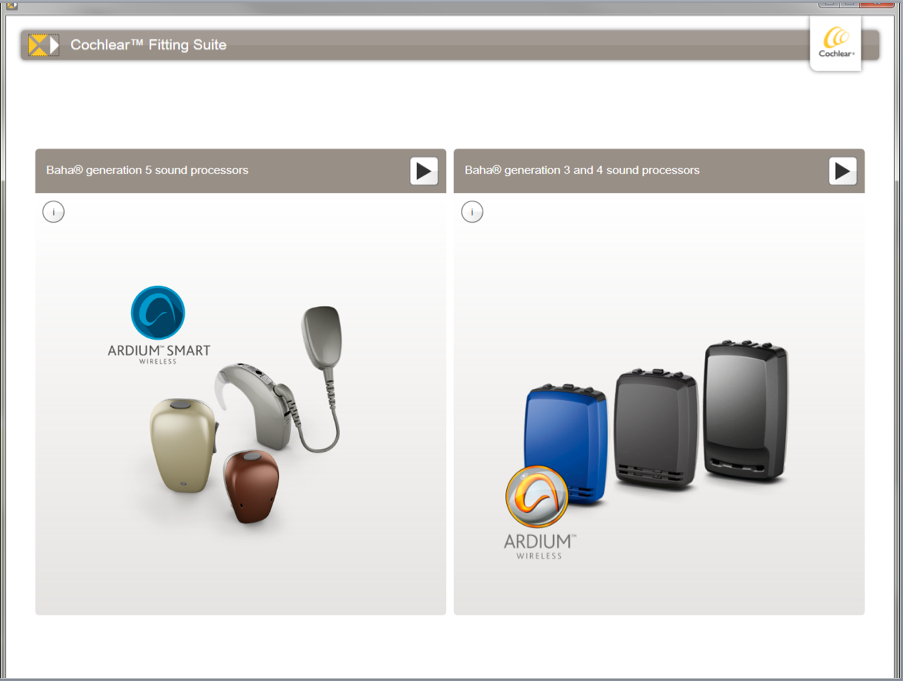
Figure 14. Fitting software, home screen.
After you select the appropriate software, you will arrive at this initial screen (Figure 15). Here we can capture name, birthdate, address, and whatever demographic information you would like to track.

Figure 15. Fitting screen, patient information.
This software is available in a standalone configuration and also as a module that you can use within the NOAH environment. There are some small differences in terms of how you enter the data. For instance, if you're using the Baha Fitting Software suite under NOAH, you would be entering the demographic data and the patient's audiogram in the NOAH environment, and that automatically gets ported into the fitting screen when you select the software option.
As you progress to the next screen in the fitting flow (Figure 16), you enter the patient’s bone conduction thresholds. Remember that bone conduction thresholds are the most important piece of information that the fitting software needs to make determinations about the device and the amount of gain it applies. You have the option to enter the air conduction threshold values as well, so that that will print out on your final report. In this screen, you simply can point and click, or you can use the grid at the bottom and type in the values.

Figure 16. Entering bone conduction thresholds.
The next screen is where you inform the software what sound processor you will be using (Figure 17). In this example, I selected the Baha 5 family, so you can see that you have the option to choose the Baha 5, the Baha 5 Power or the Baha 5 SuperPower sound processor. By clicking on the appropriate side and device, that moves you to the next step in the process. In this case, I selected a Baha 5 Power Sound Processor.

Figure 17. Sound processor selection.
In the next screen (Figure 18), you'll see the selection choices. At the very top, you have the ability to select the interface, which is important in terms of how you're going to have the computer connect to the device. The Airlink 2 that we can supply to clinics is a wireless functionality that allows the Baha 5 family of devices to be programmed wirelessly, and it's a very robust fitting. If you select the change button, you can also select the NOAHlink and also the NOAH HI-PRO 2 Device. If you switch between programming interfaces, you have to remember to change the selection.

Figure 18. Sound processor connection setup.
In the middle of the screen, you have the ability to select what you want to base the fitting on. In this particular case, we selected “fitting software,” which will take the audiogram that we entered earlier and derive the fitting. To read the device or look at what is in the device during a patient’s follow-up visit, simply select “sound processor”; this will read the device and let you pick up where you left off. The “factory settings” selection affords you the ability to restore the device back to the way it was when it was manufactured. Once you've made your choice, select the “detect” button to proceed to the connection phase.
The software will prompt you as needed. In this example (Figure 19), we're using an Airlink 2, and it indicates that I need to place the battery in the device and close the battery contact to initialize the discovery mode and make the wireless connection. Once the wireless connection is made, click the yellow “select” button to complete the connection process. The device will then connect, and you'll move to the next step in the process, which is the ability to run the feedback analyzer.

Figure 19. Sound processor connection setup.
Feedback Analyzer
We have a very robust feedback analyzer (Figure 20) that measures open loop gain and optimizes the fitting for each patient relative to the type of connection (e.g., a Softband, a Baha Attract or a Baha Connect). This only takes about 7-10 seconds. The device produces an audible signal during the test, and establishes the individual’s stable gain curve that will allow for the device to be fitted without any feedback risk.

Figure 20. Feedback analyzer.
In the process of making that measurement, you will see an indicator if the background noise is too loud during the test. You need a quiet environment in which to do this analysis. When the feedback analysis is complete, click “ok” and you will see a message that the connection is complete. At this point, you can choose to either go to an Express Fit or a Detailed Fit (Figure 21).

Figure 21. Choose Express Fit or Detailed Fit.
Detailed Fit
The Detailed Fit goes directly to a screen that gives you full function. In step A, you have the ability to tell the software what type of patient you're fitting (an adult or a child). Next, if it is a bilateral fitting, be sure the “on” button is selected; if it’s not a bilateral fitting, select “off” and click the “next” button (Figure 22) to move on to step B.

Figure 22. Detailed fit mode.
In step B, you need to inform the software what type of hearing loss you are fitting. In our example, the patient has a mixed conductive hearing loss (Figure 23). By clicking “next,” it moves to step C, where you must indicate what type of fitting you're doing (Baha Attract, Baha Connect or Softband). In this particular example, the clinician was going to do a demo on a Softband (Figure 24).

Figure 23. Select hearing loss type.

Figure 24. Select fitting type.
Next, we move to the BC Direct screen (Figure 25). BC Direct is our method of in situ measurement, and we find it highly useful and well worth the time. In this example, you have the ability to convert the Baha as it's worn on the patient's head into the transducer, and the software then creates an audiometer-like function to present pure tones at the various test frequencies. You'll notice that there are some indexed marks on the audiogram in Figure 25 from 500 through 4000 Hz where we recommend that these data points be measured. The red line represents the audiogram that was entered at the initial phase of the fitting. The differences between the measured audiogram and the measurement through the way the device is connected allows the software to make further calculations about how the target should be set up, in order to apply the appropriate gain.

Figure 25. BC Direct screen.
You can select a pure tone or a warble tone, which is useful in patients who may have some tinnitus. You can use the keyboard and space bar to present the tone, or you can click the software button with the music note to present the tone. There is a talk-over feature that allows you to turn the device on and give the patient further instructions. In this example, we’ll do threshold measurements. We recommend testing 500 Hz, 1 kHz, 2 kHz, and 4 kHz as a baseline, but you can do all the frequencies if needed, in order to create the targeted formula.
After you have completed the BC Direct measurements, you receive a message asking whether or not you want to recalculate the fitting based on the fact that you've changed the prescription. To use the BC Direct measurements as your basis for calculating the target, select “yes.”
Then you arrive at the fitting screen. In Figure 26, the lower edge of the dark grey zone at the top represents the maximum fitting range. The black line that follows at the bottom of the yellow zone is the actual measured individual stable gain curve. Remember on the earlier slide I showed the feedback analyses? That is this patient's individual stable gain.

Figure 26. Fitting screen.
What happens when we go live with the fitting? The red curve represents the gain curve that is prescribed relative to the targets. It stops before it crosses the black line. If desired, you have the capability to override this in the fitting software and move into the yellow zone. This yellow zone is an area of caution; there is some probability that if you adjust gain into the yellow zone, you may have some feedback issues. The screen in Figure 30 is in the Express fit that gives you access to the Hearing Mentor. This is a good tool to use for individuals at their first fitting, because they often don't have the experience to be able to give you detailed descriptions of what they like or dislike. You can see the descriptions of sounds, each with a sliding scale (softer or louder, fuller or brighter, comfort or clearer). This will make some global changes. In the Detailed fit mode, you'll have access to a more detailed fitting grid and access to 1 dB increments in all of the adjustment handles across devices.
When you're done with the fitting, you have the ability to see a summary of what you have set up (Figure 27). In this example, we have one program, the patient type is an adult, they have a mixed/conductive loss, etc. When you have reviewed everything and determined that the information is accurate, click “save”.

Figure 27. Fitting summary.
Case Studies
I would like to share with you the following two case studies where we tested the Baha 5 SuperPower.
Patient Case #1
This patient was a 33-year-old female who presented to us with a history of a left ear acoustic neuroma with removal. After that surgery, the patient selected Baha as her choice for a fitting and selected the Baha Attract implant system as it met her lifestyle requirements. She was successfully implanted with the BI 300 Implant with a Number 3 Sound Processor Magnet, and a Baha 5 Sound Processor. She was using it for about eight months prior to her visit for the study.
What she reported in the pretesting interview was that she had less than satisfactory outcomes with her Baha 5 fitting, and she had a brief trial with a BP110 (the Power device of choice at that time), which provided her with minimal improvement.
As you can see in Figure 28, her right ear was normal, fitting the criteria of better than 20 dB in the better ear. The left ear, because of the acoustic neuroma removal, was a dead ear.
The blue line in the middle of Figure 28 represents the BC Direct thresholds that we measured with the Baha 5 device and also with the Baha 5 SuperPower device that was under test. What you'll notice is a large shift downward between the bone conduction thresholds for her right ear. We attempted to stimulate that cochlea from the opposite side where the implant was placed on her dead ear side. This is a case of a patient with a large transcranial loss.
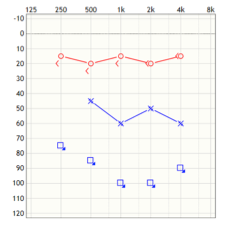
Figure 28. Audiometric profile – Patient #1.
This case was unique in that because of the way the surgery was performed and the amount of bone excavation that was done, it modified her skull to some degree, and she wasn't getting as an effective transmission of sound across the skull to access the transcranial routing of signal. That's why she didn't like the Baha 5 very much; she received minimum benefit.
The patient’s aided sound field thresholds are shown in Figure 29. For patients with SSD, it's often difficult to test the poorer ear without involvement of the better ear. In this case, we plugged her good/right ear, and the blue open squares represent measured sound field thresholds in the sound booth with no device. Then, we attached the BP110 for comparative purposes (blue Xs), and it improved her functional gain to some degree, but not in any meaningful way. The red curve represents her sound field threshold measurements with the Baha 5 SuperPower device fitted in the BTE configuration. She was very excited about what she was hearing and could tell immediately that the Baha 5 SuperPower was making a difference in terms of her previous experience with her Baha Attract.
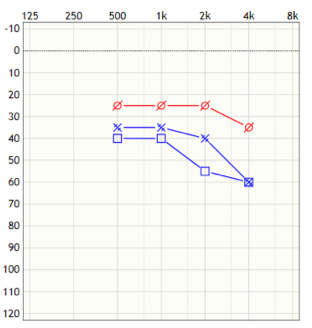
Figure 29. Aided sound field thresholds with Baha fittings (blue open squares = unaided with better ear plugged; blue Xs = BP110; red curve = Baha 5 SuperPower).
Table 1 shows the patient’s CNC word recognition in quiet.

Table 1. CNC word recognition in quiet.
Using no device, she was getting 74% speech discrimination. Using the BP110 improved her speech CNC scores to 86%. With the Baha 5 SuperPower, she scored 100% correct. We opted to do this at a higher input level of 65 dB. Again, because of the inability to take the good ear out of the hearing testing, her speech understanding in the unaided condition was 100%. Wearing her Baha, we see 96% to 98% respectively with the BP110 and the Baha 5 SuperPower.
When we look at the HINT testing, we see some nice results (Table 2).

Table 2. HINT test results.
With no aid, she was coming in at a -2 SNR. Her BP110 was providing a -1 SNR, and she was getting a -3.2 SNR with the device configured where we had all of the automatic features deactivated and were just using the microphone. In this test scenario, we were presenting the speech at 0 degrees Azimuth in front of the patient, and we were presenting the noise from 180 degrees directly behind the patient. We were very pleased with those results.
Patient Case #2
Patient 2 was a 56-year-old female who had a history of a repaired cleft lip and palate at a young age, and a reported history of life long ear problems and hearing loss. She had undergone multiple surgeries to her ear, and we were struggling to find devices that would work for her. The patient had selected a Baha Attract System, and was fit with a BP110 sound processor. She was also using a #2 strength Sound Processor Magnet. She’d had the Baha on her right side for one year and was using it consistently. Recently, just before her visit, she had added an acoustic hearing aid to the right ear where she had an ear canal that could support an acoustic fitting. She reported her dissatisfaction with her current BP110 fitting, but was getting by with the combination of the hearing aid and BP110.
Figure 30 shows the air and bone conduction hearing thresholds for her right and left ears. As she has a mixed hearing loss, we tried the Baha 5 SuperPower device.

Figure 30. Audiometric profile – Patient #2.
Figure 31 shows the aided sound field thresholds. Keep in mind that we took the hearing aid out of the right ear and plugged that ear, and we measured the test ear without any device on (depicted by the open circles). The blue Xs represent what she was getting with the BP110 and the Baha Attract fitting. With the Baha 5 SuperPower, depicted by the uppermost red line, she was able to hear quite nicely up into the 25 dB range. She was very pleased.

Figure 31. Aided sound field thresholds – Patient #2.
Table 3 shows this patient’s results on speech testing with CNC words in quiet.
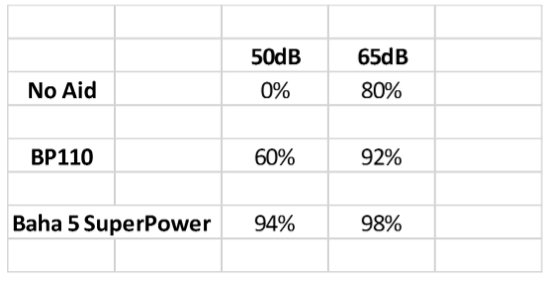
Table 3. Patient 2, speech recognition testing results for CNC words in quiet.
Again, with no hearing aid on and the opposite ear plugged, she was giving us no response or no recognition whatsoever at 50 dB. With the BP110, she was getting about 60% speech understanding in quiet. With the Baha 5 SuperPower, she was getting 94%. With a 65 dB input, we were able to see a similar trend in terms of improvement.
Finally, let’s look at Patient 2’s ability to hear sentences in noise in Table 4.
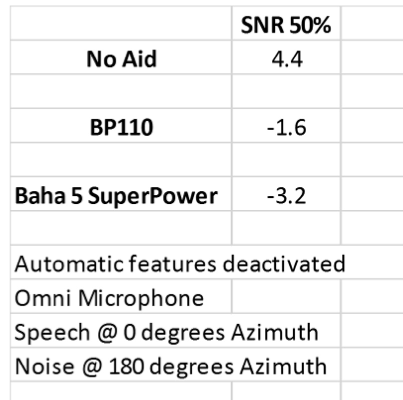
Table 4. Patient 2, speech testing in noise using the HINT.
Without using any device and with the non-test ear plugged, she was getting about a 4.4 dB SNR. With the BP110, she improved to -1.6. With the Baha 5 SuperPower she had -3.2 SNR which was a significant improvement in her overall ability to hear in noise. We had the automatic features deactivated in this particular scenario. We were looking at a function with an omnidirectional microphone, with speech coming from 0 degrees Azimuth and noise coming from behind at 180 degrees.
Summary
In summary, Cochlear has a very robust implant system with a long history of success. We offer patients the choice of connection types, and clinicians the ability to use the Baha 5 Softband as a test bed for preoperative counseling and evaluation. We're happy to now offer the Baha 5 SuperPower and Baha 5 Power to round out this portfolio of devices. The portfolio offers excellent technologies for all levels of hearing loss, all the way up to 65 dB sensorineural level. As we introduce new products, we always strive to improve the workflow in the fitting software. With bone-anchored systems, the utility and the acceptance of the True Wireless technology has been amazing. Thank you for your time and attention. Please feel free to email me if there are any additional questions: gcire@cochlear.com
Questions and Answers
When I have an SSD patient with normal hearing in the opposite ear, how do I decide which processor to order, the Baha 5 or the Baha 5 Power?
First, look at the bone conduction levels that you have in the good (or only hearing) ear. Then, look at how the device is attenuating across the skull. If you were able to test this patient preoperatively, you would be able to use the Softband and BC Direct to see what kinds of levels that you had, and that would help to determine which sound processor to use. If you have your BC Direct values coincident with your entered bone conduction thresholds from the good or only hearing ear, and it's an on-label fitting at 20 dB or better, use a Baha 5 and demonstrate that. If the BC Direct score is greater than about 20 or 25 dB, the Baha 5 Power device could be the better choice.
When fitting the Baha Attract System for the first time, does the fitting kit come with multiple strengths of processor magnets?
The fitting kit currently sends two different strengths of processor magnets, depending upon whether it's an adult or a child. We encourage clinicians to hang on to the unused magnets and try to collect different strengths so that you have those available. You can have a discussion with your Cochlear representative about what options are available for you.
How do you tell if a patient is better with the Baha Attract or the Baha Connect system?
That question is probably best answered by using an evaluation tool that one of our local reps can provide to you. You test the device on the Softband using a flowchart, and also take into consideration the aided results that you collected preoperatively on the Softband to determine what sound processor is better. In addition, the decision to use Attract or Connect rests largely with either the patient or the surgeon. It can be a coin toss at some points, and the ability to test this device using the sound processor on the Softband is quite useful.
Citation
Cire, G. (2016, October). New treatment options for patients with SSD and mixed hearing loss. AudiologyOnline, Article 18341. Retrieved from https://www.audiologyonline.com


